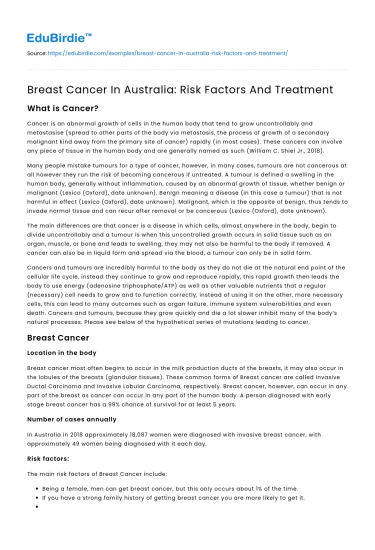Introduction
Breast cancer remains a significant public health concern in Australia, being one of the most prevalent cancers among women. The Australian Institute of Health and Welfare reports that it is the second most common cause of cancer-related deaths among Australian women. Understanding the risk factors and treatment options for breast cancer is crucial, as it not only aids in early detection and effective treatment but also contributes to public health awareness and research advancements. This essay delves into the primary risk factors associated with breast cancer in Australia, explores the current treatment modalities available, and discusses the implications of these factors on public health policies. By examining the interplay between genetic predispositions, lifestyle choices, and environmental influences, we can better understand the complexities of breast cancer, ultimately paving the way for improved preventative measures and therapeutic interventions.
Risk Factors Contributing to Breast Cancer
Breast cancer risk factors in Australia are multifaceted, encompassing genetic, lifestyle, and environmental elements. Genetic predispositions, particularly the presence of BRCA1 and BRCA2 mutations, are significant contributors to breast cancer risk. According to the Cancer Council Australia, women with these mutations have a 45-65% risk of developing breast cancer by the age of 70. This genetic susceptibility underscores the importance of genetic testing and counseling in at-risk populations. Lifestyle factors, including alcohol consumption, obesity, and sedentary behavior, also play a critical role in breast cancer risk. A study published in the Medical Journal of Australia highlights that women who consume at least two alcoholic drinks per day have a 20% increased risk of breast cancer compared to non-drinkers. Additionally, obesity has been linked to a higher incidence of breast cancer post-menopause, with studies suggesting that excess adipose tissue increases estrogen levels, thereby promoting breast cancer growth.
Save your time!
We can take care of your essay
- Proper editing and formatting
- Free revision, title page, and bibliography
- Flexible prices and money-back guarantee
Environmental factors, such as exposure to radiation and endocrine-disrupting chemicals, further compound breast cancer risk. The Australian Breast Cancer Tissue Bank notes that exposure to ionizing radiation, particularly during medical treatments, can increase breast cancer susceptibility. Moreover, endocrine disruptors, found in various consumer products, may interfere with hormonal balance, potentially elevating breast cancer risk. While these risk factors are significant, it's noteworthy that not all individuals with these exposures develop breast cancer, indicating a complex interplay of genetic and external factors. This complexity necessitates a comprehensive approach in both research and clinical practice to identify individuals at heightened risk and tailor preventative strategies accordingly.
Treatment Modalities for Breast Cancer
Treatment for breast cancer in Australia consists of a combination of surgical, radiotherapeutic, and pharmacological interventions, tailored to the cancer's stage and the patient's individual needs. Surgery, including lumpectomy and mastectomy, remains a cornerstone of breast cancer treatment. The choice between these surgical options depends on the tumor's size, location, and the patient's preference. Advances in surgical techniques, such as sentinel lymph node biopsy, have improved outcomes by minimizing the extent of surgery while ensuring effective cancer control.
Radiation therapy is often employed post-surgery to eradicate residual cancer cells, thereby reducing recurrence risk. The Australian Radiation Protection and Nuclear Safety Agency (ARPANSA) reports that modern radiation techniques have significantly enhanced targeting precision, minimizing damage to surrounding healthy tissue. Hormonal therapies, such as tamoxifen and aromatase inhibitors, are integral to managing hormone-receptor-positive breast cancers. These treatments work by blocking the body's natural hormones from supporting cancer cell growth, significantly reducing recurrence rates.
Targeted therapies and immunotherapy represent the forefront of breast cancer treatment innovation. Drugs like trastuzumab (Herceptin) target specific proteins that promote cancer growth, offering hope for patients with HER2-positive cancers. Immunotherapy, though still in early stages for breast cancer, holds promise as a future treatment avenue. Despite these advances, challenges remain, including treatment resistance and side effects. Ongoing research and clinical trials continue to explore novel therapeutic strategies to address these issues, emphasizing personalized medicine's role in future breast cancer care.
Conclusion
In conclusion, breast cancer in Australia is influenced by a complex array of risk factors, including genetic predispositions, lifestyle choices, and environmental exposures. Understanding these factors is crucial for developing effective prevention and treatment strategies. Current treatment modalities, ranging from surgery to targeted therapies, offer diverse options tailored to individual patient needs, yet challenges such as treatment resistance and side effects persist. Addressing these challenges requires ongoing research and innovation, with a focus on personalized medicine to improve outcomes. Public health initiatives must prioritize awareness and early detection, emphasizing the importance of regular screenings and lifestyle modifications to mitigate risk. By fostering a collaborative approach between researchers, clinicians, and policymakers, Australia can continue to advance in its fight against breast cancer, ultimately improving the quality of life for those affected.






 Stuck on your essay?
Stuck on your essay?

